Repowering The ELB - Extremely Light Boat
AKA The Cowmaran
Toward the end of March 2012, the Cowmaran reappeared in my yard, this time with a second engine hanging on the transom. The original design concept called for twin engines on an ultra-light catamaran, but Don had tried it out with just one engine initially to see how it would do. Single engine performance was decent, but the boat was not quite able to maintain a ten knot cruising speed when loaded and dealing with wind and chop.
The highest speed I saw with the single engine was 12 knots at full throttle in calm water, but our speed at cruise power fell to an average of about 9 knots in harbor chop. That did not quite satisfy, especially considering that wind drag will increase when the boat gets some much-needed shade. The solution was to put a second Tohatsu 9.8 hp engine on the boat.
The new engine is a model I did not know was available from Tohatsu, despite my previous employment in a Tohatsu dealership. It is a 9.8 hp with electric start and power tilt/trim, and it is a remote-control ready engine. The other engine is a tiller engine that has remote controls cobbled onto it, but because it is not a remote-control-ready engine, it does not have the tube for the steering rod to pass through the engine bracket. For that reason, the single engine steering setup involved a bracket to secure the cable end near the engine.
![]()
As the picture at left shows, the new engine has the steering tube built into the bracket. Passing the steering cable through the tube is impossible in this application because the engine is too close to the edge of the boat. The steering cable would be hanging out over the side of the boat.
The center of the transom has a reinforcing box under the deck to help distribute engine loads from the single engine. The two ama transoms are reinforced inside, but needed a bit more surface structure to avoid cracking the skin of the boat. A small piece of marine plywood with a bit of fiberglass cloth epoxied over it was installed on each side prior to clamping on the engines. The prototype-in-development look was partially offset by the nice curve Don's friend Paul gave the transom when trimming it down a bit. The port side is a bit more rugged in appearance.

I stuck these two pictures together to show the different engine brackets used on the tiller vs remote control versions of the Tohatsu 9.8. The bracket for the starboard (remote control version) engine is much larger and heavier and has the power tilt hydraulic cylinder sticking down from the bottom. That engine also came with a four-bladed "eggbeater" high-thrust propeller. The prop on the port engine is a standard prop that would be used in a dinghy application and another one was put on the starboard engine, but it turns out that those propellers are not right. More on that to follow.
Update 2/20/13: The not-quite-twin engines are becoming actual twins. A new engine with power tilt for the port side has arrived and will be installed soon!
The process of bringing the boat here with the twin engines was not without lessons. One was: snowmobile trailers float. Don had to walk out onto the floating trailer to get it to sink far enough to load the boat well forward on the trailer. They wanted to load it forward to ensure adequate tongue weight for towing. Adding a hundred pound engine and related equipment to the stern of such a light boat will move the center of gravity noticeably.
The problem with this loading arrangement became apparent during the first hard right turn. If you click to enlarge the picture, you can see the small dent that the starboard bow of the Cowmaran put in the rear quarter panel of the tow vehicle. Oops. Maybe not quite that far forward next time.

The results of the car vs boat conflict can be seen in the picture at right. Although Detroit's finest suffered a sizable dent, the result was only a little bite taken out of the bow of the Cowmaran. Don skipped that area when coating the bottom with some antifouling bottom paint in anticipation of some upcoming cruising activities. After cleaning it out a bit, he filled the area with West System epoxy thickened with microballoon fillers and then pinched it smooth using a piece of wax paper.
The resulting patch came out pretty smooth after the patch cured and the wax paper was peeled away.

Don had a local welding shop make up a steering tiebar that would connect the two engines together and allow both to be steered using the existing cable and bracket from the single engine installation. The starboard engine has a standard remote steering "tiller" piece on the front of the engine, so connection at that end was pretty straightforward. The port engine has a bit of a jury rig, but it works.
This picture shows the connection between the tie rod and the steering cable end. They welded a piece of threaded tubing to a post on the rod, allowing a flexible ball and socket joint to be screwed into it. That joint is bolted to the steering push/pull rod. The cable and the sleeve holding the steering rod are held by the transom bracket used for the single engine steering setup.

The steering cable bracket was removed from its mounting in order to free up the tie bar for adjustment. There are threaded swiveling connectors at both ends. In the picture at right, Don is adjusting the port engine swivel connector to make both engines line up properly when set to go straight.
It took a couple of tries, but in the end both engines turned through the proper range and lined up straight in the middle. A few washers were needed to provide spacing so that all the parts clear in hard over turns. The only remaining clearance problem is not steering related: the aluminum railing is too low to allow the engines to tilt up all the way. Until that issue is resolved, we have to be very careful with the power tilt. If the hydraulic tilt motor forces the engine cowling up into the railing, something will break.

With the twin engine steering system working, Don immediately set about installing twin remote controls. These side-mount remote controls used for small engines are not really suitable for twin engine applications, so he had to invent a way for it to work. Unfortunately, he did not ask me before mounting the first remote control on the port side of the console. He did not know they are reversible, something I had learned when installing a similar control in the cockpit of our Corsair F-27 trimaran.
The existing remote control is not moving for now, so the answer was to have a metal shop make up an aluminum bracket that would hold the second control up outside of the first one.
The twin engine controls as they are installed look like an inelegant solution worthy of a prototype. It works, though the power tilt switch on the starboard engine is a bit obstructed and it is impossible to shift both engines at once with one hand. The real answer to these problems is a proper twin engine remote control, but right now the question is more whether the engines are right for the boat than whether the remote controls are ergonomic and attractive. They are not, but it does not matter for now.

Once the replacement for the eggbeater prop arrived, the Cowmaran was ready for a test run. While working on the computer last Wednesday, I got a call from Don asking whether I wanted to go for a Cowmaran ride up the Peace River. I knew I should really work instead, but you only live once and there are some questions to which I just can't say no. "Do you want to go boating?" tops the list of those questions. Soon Don and Fred appeared off my neighbor's dock in Shell Creek.
I took a picture of the twin engines as soon as we left the dock, while still traveling at slow speed. The wake is different from the single engine wake. The big difference is most visible at the left side of this picture: large, rolling waves extending out almost perpendicular to the boat. The normal hull wakes are quite small, but these big waves are out there and it takes power to create those. Examination of the video I shot led me to believe that there might be a trim problem, with the bows a bit too high.

As we picked up to cruise speed, the strange rolling wake disappeared. In this photo we were going over 10 knots and barely creating a ripple, but later on in the day we were making a large, rolling wake even at this speed. It remains a Cowmaran mystery to me for now.
Out in the Peace River, we did a bit of performance testing on the way up river. We were running against wind and tide and determined that turning around added a full knot to our speed, so the wind and current were costing us about half a knot upwind/upstream and adding as much going down. The boat cruised at about 13 knots with the engines running at 5,200 RPM. In calm wind and water, it would have averaged 13.5 knots.

At the max rated 6,000 RPM on each engine, the boat went 14.5 knots, so a calm water speed of 15 knots. It was outrunning the propellers badly at this point. There was some room left to throttle up more, but not without over-revving the new engines. The last few hundred RPM made a difference mostly in noise, not speed, another sure sign that the boat has overrun the propellers and needs higher pitch props. As I write this, new props with half an inch more pitch have been added to the boat, but even those only brought the max RPM down to the mid-5,000 range. That is right in the middle of the manufacturer specification, but props with yet another half an inch of pitch are on order.
We are running out of sources of drag that can be eliminated on this boat and were discussing what else could be done to improve performance. Looking at the engines on dry land, I had noticed that the cavitation plate is a couple of inches below the extended plane of the hull, meaning the engines could be mounted at least that much higher on the transoms. Don decided that the middle of the Peace River was as good a place as any to adjust motor height. That's a good way to send an engine for a swim, but he pulled it off.
Moving the engines up an inch or so did not make a noticeable performance difference. To the extent that things changed, the boat actually got slower. That seems strange, but that's what happened.

We stopped in at the Nav-A-Gator Grille for lunch and slung the boat across two slips, partially blocking access to a third. This would not have been popular on a weekend, but there were plenty of open slips.
After lunch, we headed on up the Peace River. Don asked how far we could go and my answer was that the river goes a lot further than we have time to go. Parts of it are shallow at this time of year, but if you are careful and willing to drag the boat over the occasional sand bar, it should be possible to make it to Arcadia and beyond.

Just past the County Rd 761 bridge is this broken down old wooden bridge at the end of River Street in Fort Ogden, FL. We went a mile or two past this bridge before shallow water and lack of time made us turn around.
The water in this part of the world is generally stained brown by tannins and if it is stirred up at all, visibility approaches zero. We found the river water relatively clear and could see the bottom in about two to three feet of water. Being able to see the bottom is kind of unusual and makes me a bit nervous in this area. It almost always means it is waist deep or less, and sometimes it means you just hit.
I attempted one detour in a side branch of the river, but it was too shallow. We bounced off a couple of submerged logs and had to spin the boat in marginal water to escape. Because of a strong wind blowing us further down the shallow branch, it would have been a bad spot with the single engine. The only way out would have been to get out of the boat and grab the bow to let the wind swing it around.

This section of the Peace River is scenic and shallow. Once again, that large, rolling wake showed up some of the time. It was particularly visible in the shallows and where it would break over sand bars by the shore. It might be associated with acceleration/deceleration because it is not always present.
Another shot of the rolling Cowmaran wake. It does not act like a normal boat wake, making an increasingly sharp V as speed increases. It just goes more or less straight out.

I stuck the camera down under the bow and took a shot looking back between the hulls, hoping it would reveal something about why those large, rolling waves are appearing in the wake. It did not answer any questions, but is kind of an interesting photo anyway.
We cruised back down the river and they dropped me off at my neighbor's dock on Shell Creek. I had them run back and forth for a quick photo shoot before heading back to Punta Gorda. Here the Cowmaran is approaching the dock at a fairly high speed. No big, rolling wake at all. Where did it go?

The view from astern as she went by also does not show the strange, rolling wake. It shows just what I would expect, and what we see most of the time: two tiny little wakes coming off each hull and nothing else.
The close passes at speed were pretty fun to watch. The boat and engines are very quiet and do not throw around a lot of white water, so it appears to be approaching more slowly than it actually is going. It then suddenly arrives and zips by with surprising speed. Check out the video below for some footage of the Cowmaran in Shell Creek.
Today (April 14, 2012) we went to watch the Dragon Boat races off downtown Punta Gorda and I got my first ride with the new props. With a 15-20 knot headwind and harbor chop tall enough to smack into the crossbeams under the deck, the engines wound up to about 5,200 RPM and the boat went 15 knots. The wind and chop were taking at least a knot off of our speed, so it looks like the new props make it a knot or two faster throughout the speed range. These props have a 9" pitch and feel right for the boat. A pair of 9.5" props are on the way, but I suspect those will only be useful in ideal conditions.

Some Video of the Cowmaran in Action:
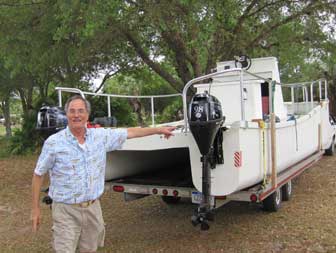
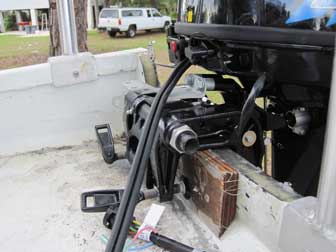
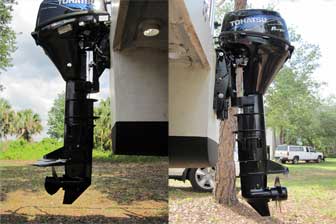
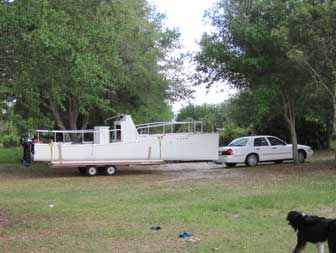
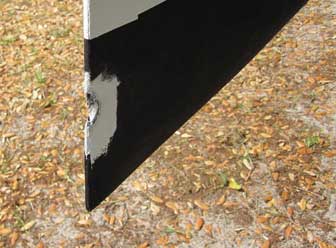
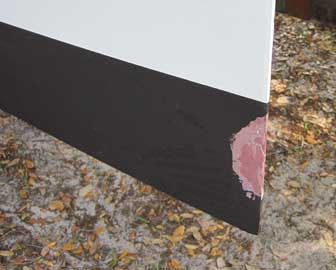
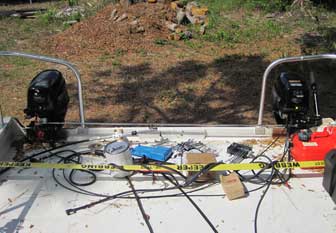
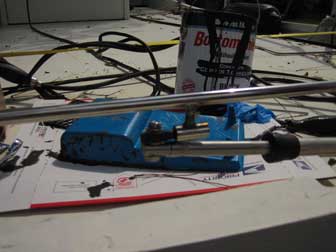
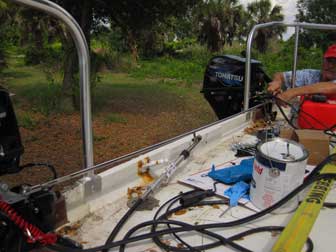
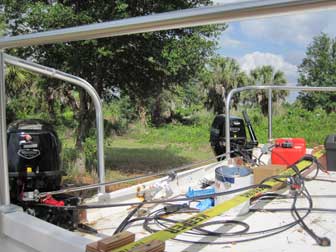
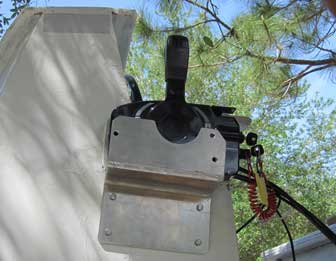
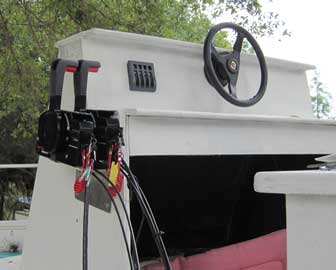
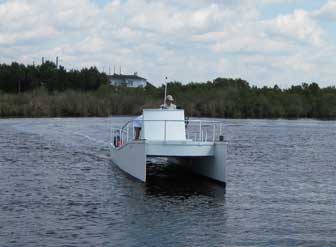
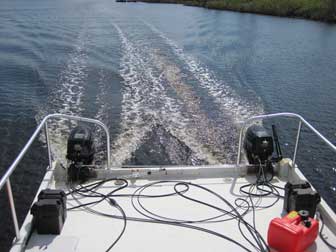
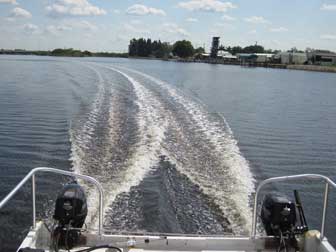
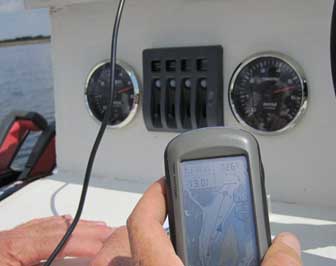
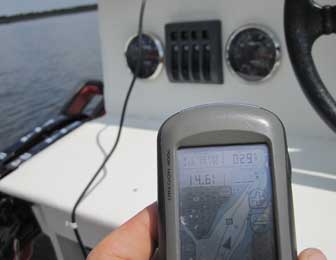
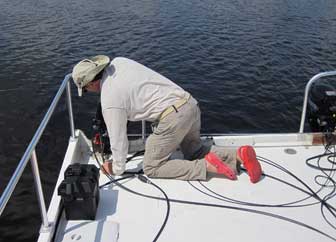
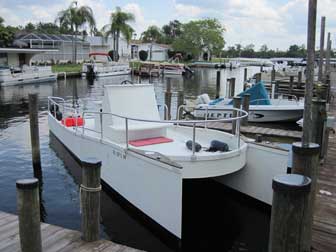
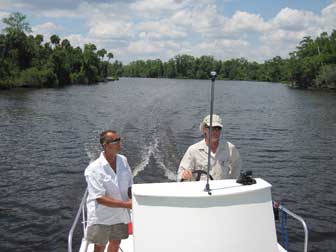
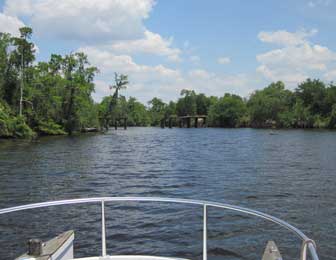
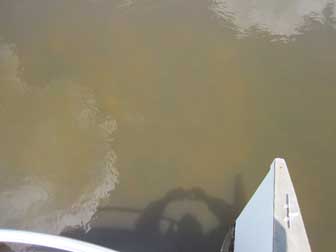
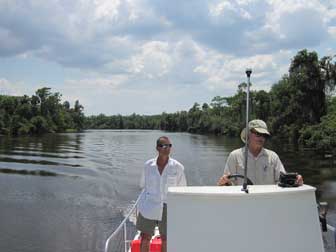
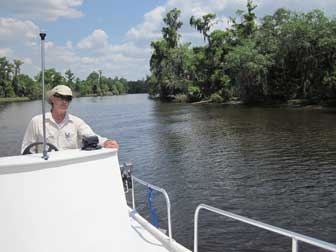
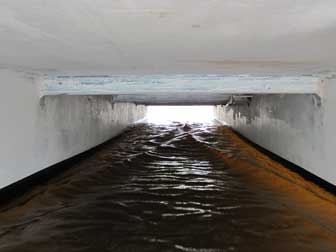
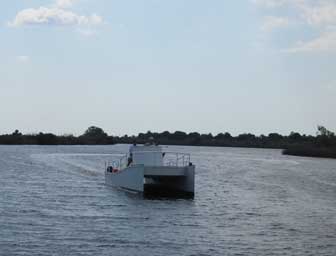
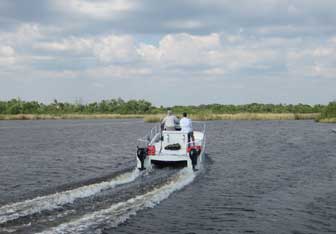
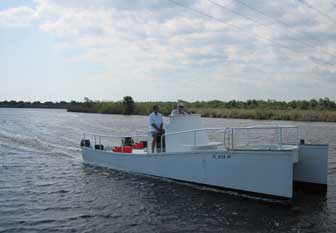
Well done fellows.
Good to see others exploring the light catamaran with very small engines conundrum.
I found with my 40 footer if we kept the bows trimmed down we got a little extra speed.
Have now sold that boat and am building a 46′ sailing cat but my retirement boat will be a 30′ x 10′ motor cat with 2 x 20hp Tohatsu.
We travel 70 miles offshore up to the G.B. Reef for a week at a time.
Hope to cruise at 10/12 knots using 6/8lts pr hr.
regards
Bob
That sounds like a good size for this type of boat. A bit big to trailer, but should handle well with a bit of a load and be quick and efficient. Good luck!
I write this on board our Skoota 28 powercat. We have fitted twin 20hp Tohatsus and do 16 knots flat out, cruise at 10-12 at 6-7mpg
it’s a very comfortable live aboard boat and economic to run (for a powerboat!)
PS I actually got to your site as I was interested in the handheld gps you reviewed. Does it really have a too-dark-to-be-useful screen?
I had not see the Skoota before. Thanks, Richard! If you are talking about the Garmin Oregon handheld, we still have ours. The screen is OK. It is just kind of small and the touchscreen does not always work smoothly. I find myself placing waypoints when I just meant to move the map, things like that. It is getting a bit old now, new models may be better.
Hi Tom,
I would like to know the displacement weight of the Cowmaran.
What is the total cost to build the Cowmaran. Thanks
Warm Regards
P.Y. Chiu
Mr Chiu,
Sorry for my late reply, I did not notice your comment until today. The Cowmaran hull with no engines or controls weighs about 1,000 lbs. The build cost is unknown to me.
Tom, I’m interested in building something similar. Did you start with a set of plans or did you design this yourself? Looking for an alternative to a pontoon boat but want a similar layout.
I did not build or design the Cowmaran, but the guy who did plans to produce what you want. The new one will be about the same size, somewhat different hulls, lower freeboard, and twin 20 hp engines.